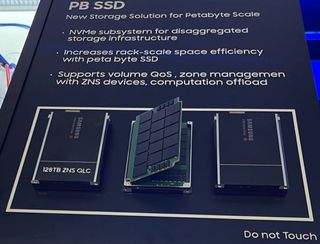Samsung Unveils 128TB PCIe SSD to Tackle Petabyte-Scale Storage
Samsung's 128TB SSD looks to make a splash in the enterprise market.

Samsung has consistently fielded some of the best SSDs on the market, with solutions to satiate performance, value, and capacity needs. The South Korean company this week unveiled a new SSD that takes capacity to the extreme with a 128TB SSD to drive petabyte-scale storage.
Understandably, the SSD uses quad-level cell (QLC) NAND to achieve this enormous level of storage along with an NVMe PCIe interface. According to Blocks and Files, the SSD has two PCBs inside, which hold the NAND flash and the SSD controller. These PCBs communicate via a ribbon cable. The placard for the SSD also says that it supports volume quality of service (QoS), zone management, and computational storage.
“The new solution will allow a single server unit to pack more than one petabyte of storage, enabling server manufacturers to sharply increase their storage capacity within the same floor space with a minimal number of servers,” said Samsung in a press release talking about advances in petabyte storage. “High server utilization will also help to lower power consumption.”

It’s interesting to note that Samsung first showed off a 128TB SAS SSD way back in 2017. That product also used QLC NAND, albeit with a 1TB die size. Today, companies like Micron are already pushing the 2TB per chip barrier with 232-layer NAND.
Samsung isn’t the only company pushing boundaries with SSD storage for the enterprise market. For example, Nimbus launched its 100TB 3.5-inch SATA SSD two years ago, initially priced at a staggering $40,000. However, the Nimbus SSD's performance would pale in comparison to Samsung’s new 128GB monster since it tops out with sequential reads/writes of 500 MBps and random reads/writes of 114,000 IOPS and 106,000 IOPS, respectively.
Unfortunately, Samsung didn’t announce pricing or availability for the new 128TB SSD. However, the company’s 32TB PM1643a 2.5-inch SAS SSD will set you back over $7,000 — and quadrupling the storage won’t come cheap.
Stay On the Cutting Edge: Get the Tom's Hardware Newsletter
Get Tom's Hardware's best news and in-depth reviews, straight to your inbox.
Brandon Hill is a senior editor at Tom's Hardware. He has written about PC and Mac tech since the late 1990s with bylines at AnandTech, DailyTech, and Hot Hardware. When he is not consuming copious amounts of tech news, he can be found enjoying the NC mountains or the beach with his wife and two sons.
-
bit_user I wonder if Samsung is starting to smell blood in the water, with HDD capacities appearing to plateau. Even worse is their rate of GB/$ improvement, since newer HDDs use more expensive EAMR techniques.Reply
Most Popular

